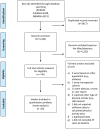Sex-Specific Exposure-Effect Relationship Between Physical Activity and Incident Atrial Fibrillation in the General Population: A Dose-Response Meta-Analysis of 16 Prospective Studies
- PMID: 34631817
- PMCID: PMC8492974
- DOI: 10.3389/fcvm.2021.710071
Sex-Specific Exposure-Effect Relationship Between Physical Activity and Incident Atrial Fibrillation in the General Population: A Dose-Response Meta-Analysis of 16 Prospective Studies
Abstract
Background: Since evidence regarding the relationship between physical activity (PA) and atrial fibrillation (AF) incidence is inconsistent among studies, we performed a dose-response meta-analysis to comprehensively evaluate the exposure-effect association between PA and incident AF and the potential sex difference in the general population. Methods: The PubMed and Embase databases were searched for eligible studies published up to July 2020 (PROSPERO: CRD42018091692). The non-linear or linear exposure-effect relationship between PA and AF was examined using the robust error meta-regression method. Results: A total of 16 prospective studies involving 1,449,017 individuals and 39,884 AF cases were included. We observed an inverse non-linear association between PA level and incident AF (I 2 = 0%, p non-linearity < 0.001). In the linear model, a 5 metabolic equivalent of task (MET)-h/week increase in PA was associated with a decreased risk of AF [risk ratio (RR) = 0.992, 95% confidence interval (CI): 0.988-0.996, I 2 = 0%]. In the sex-stratified analysis, we observed an inverse non-linear relationship between PA level and AF risk in females (I 2 = 90%, p non-linearity < 0.0001) but not in males (I 2 = 0%, p non-linearity = 0.40). In the linear model, a 5 MET-h/week increase in PA was associated with a reduced risk of AF in females (RR = 0.982, 95% CI: 0.975-0.989, I 2 = 71%) but not in males (RR = 0.998, 95% CI: 0.994-1.002, I 2 = 0%), with a significant interaction observed between the two groups (p interaction < 0.0001). Conclusion: There was an inverse non-linear relationship between PA level and incident AF in the general population. The beneficial effect of PA in reducing AF risk might be predominantly observed in females.
Keywords: atrial fibrillation; dose-response; meta-analysis; physical activity; risk factor.
Copyright © 2021 Wan, Zhou, Zhu and Liu.
Conflict of interest statement
The authors declare that the research was conducted in the absence of any commercial or financial relationships that could be construed as a potential conflict of interest.
Figures



Similar articles
-
Weekly physical activity and incident atrial fibrillation in females - A dose-response meta-analysis.Int J Cardiol. 2023 Jan 1;370:191-196. doi: 10.1016/j.ijcard.2022.11.007. Epub 2022 Nov 7. Int J Cardiol. 2023. PMID: 36356696
-
The relationship between vitamin D and risk of atrial fibrillation: a dose-response analysis of observational studies.Nutr J. 2019 Nov 14;18(1):73. doi: 10.1186/s12937-019-0485-8. Nutr J. 2019. PMID: 31727055 Free PMC article. Review.
-
Sex Differences in the Association Between Regular Physical Activity and Incident Atrial Fibrillation: A Meta-analysis of 13 Prospective Studies.Clin Cardiol. 2016 Jun;39(6):360-7. doi: 10.1002/clc.22531. Epub 2016 Mar 21. Clin Cardiol. 2016. PMID: 26997209 Free PMC article. Review.
-
Self-reported physical activity and atrial fibrillation risk: A systematic review and meta-analysis.Heart Rhythm. 2021 Apr;18(4):520-528. doi: 10.1016/j.hrthm.2020.12.017. Epub 2020 Dec 19. Heart Rhythm. 2021. PMID: 33348059
-
Dose-response relationship of cardiorespiratory fitness with incident atrial fibrillation.Heart Fail Rev. 2020 May;25(3):419-425. doi: 10.1007/s10741-019-09871-5. Heart Fail Rev. 2020. PMID: 31654178 Review.
Cited by
-
U-shaped association between the triglyceride-glucose index and atrial fibrillation incidence in a general population without known cardiovascular disease.Cardiovasc Diabetol. 2023 May 18;22(1):118. doi: 10.1186/s12933-023-01777-9. Cardiovasc Diabetol. 2023. PMID: 37208737 Free PMC article.
-
High Physical Activity Level and the Long-Term Risk of Atrial Fibrillation in Two Swedish Cohorts.Geriatrics (Basel). 2025 Jun 12;10(3):80. doi: 10.3390/geriatrics10030080. Geriatrics (Basel). 2025. PMID: 40558619 Free PMC article.
-
Racial and Gender Differences in Cardiorespiratory Fitness and Atrial Fibrillation.Rev Cardiovasc Med. 2024 Jul 11;25(7):261. doi: 10.31083/j.rcm2507261. eCollection 2024 Jul. Rev Cardiovasc Med. 2024. PMID: 39139428 Free PMC article. Review.
-
Association of Coffee Consumption With Atrial Fibrillation Risk: An Updated Dose-Response Meta-Analysis of Prospective Studies.Front Cardiovasc Med. 2022 Jul 6;9:894664. doi: 10.3389/fcvm.2022.894664. eCollection 2022. Front Cardiovasc Med. 2022. PMID: 35872898 Free PMC article.
-
Association of healthy lifestyle and the incidence of atrial fibrillation in senior adults: a prospective cohort study.BMC Geriatr. 2025 Mar 7;25(1):160. doi: 10.1186/s12877-025-05825-9. BMC Geriatr. 2025. PMID: 40055644 Free PMC article.
References
Publication types
LinkOut - more resources
Full Text Sources
Miscellaneous

